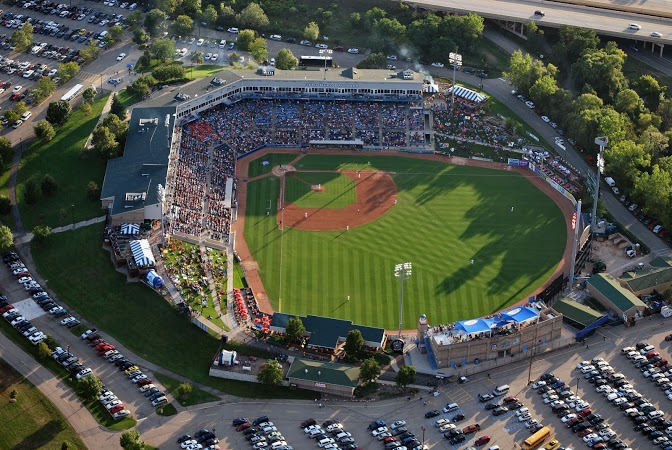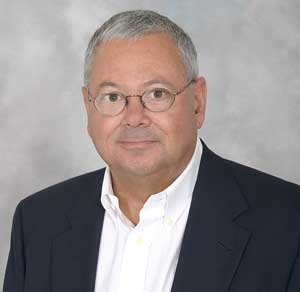Take me out to the (non-taxpayer financed) ball game
With the home opener just around the corner, the West Michigan Whitecaps are remarkable for a couple reasons.
Three months after fire destroyed half the first-base side of the ballpark, the minor league club outside of Grand Rapids is somehow set for its April 8 opener. A large crowd is expected and a local TV station, WZZM-13, will broadcast what shapes up as a community celebration.
Perhaps more notable, the franchise, a Class A affiliate of the Detroit Tigers, is one of the few professional sports stadiums in the nation entirely built and run with private investment funds.
“That was probably the smartest thing we ever did,” said Lew Chamberlin, Whitecaps CEO and franchise co-founder. “It gave us complete control of the franchise. It meant we were in no way beholden to any public bodies.”
They are joined by the Great Lakes Loons in Midland. The Loons’ $34 million minor league ballpark – known as Dow Diamond – opened on donated land in 2007, funded by a nonprofit foundation that tapped into sizable donations from Dow Corning Corporation, the Dow Chemical Company Foundation and several other foundations. It, too, relied on no public money.
Their respective business models stand in contrast to a fellow Midwest League competitor, the Lansing Lugnuts, which is seeking $11 million in public funds for a stadium renovation. That's on top of $800,000 in annual bond payments the city is still making on the stadium, which was built in 1996.
In Detroit, meanwhile, a $450 million hockey arena is to be built with $260 million in state- issued bonds paid by school and local property taxes. Despite the public largesse, the city has agreed that Red Wings owner Mike Ilitch will reap 100 percent of arena revenues, including ticket sales, concessions and parking as well as revenues from naming rights.
Sports economics expert Andrew Zimbalist said the Lugnut and Red Wing financing schemes are typical of professional sports operations across the country, and based on discredited claims of economic benefits. The Whitecaps and Loons private financing approach is the opposite.
“It's actually rare,” said Zimbalist, a professor of economics at Smith College in Massachusetts, who has authored numerous books and studies on the economics of sports and is widely regarded as a top authority in the country.
Public payoff elusive
In Lansing and Detroit, the argument for public spending on stadiums is familiar: The projects spur job creation and will boost long-term economic growth.
Lansing Mayor Virg Bernero is pitching renovation of the Lugnuts ballpark as a smart downtown investment, part of a $22 million development plan that would add 80 apartment units and a restaurant next to the outfield.
Its financing would extent city bond payments of approximately $800,000 a year another 15 years. Lansing also pays about $400,000 from its general fund to operate the stadium and make capital improvements. The team pays the city about $350,000 each year as a share of revenue.
Bernero considers the stadium “of one the gems” of Lansing's downtown and credits it for helping to regenerate the city's commercial core.
Detroit officials say a new hockey arena will revitalize a blighted area just north of downtown by anchoring a proposed $200 million residential, entertainment, retail and office development adjacent the arena.
The Detroit Economic Growth Corporation projects the arena and entertainment district will generate more than 8,000 jobs and have a statewide economic impact of $1.8 billion.
Tom Wilson, president and CEO of Olympia Entertainment, which manages Red Wings business operations, hailed the new arena a “once-in-a-generation opportunity here to make downtown Detroit a magnet for jobs and people.”
But Zimbalist and other experts say claims of economic benefit from sports franchises don't hold up under scrutiny. Zimbalist co-authored a seminal 1997 book entitled, “Sports, Jobs and Taxes” that examined the spinoff effect of several major league sports facilities, minor league stadiums and baseball spring training facilities.
Its conclusion: “A new sports facility has an extremely small (perhaps even negative) effect on overall economic activity and employment....Regardless of whether the unit of analysis is a local neighborhood, a city, or an entire metropolitan area, the economic benefits of sports facilities are de minimus.”
Zimbalist, like other analysts, said claims of economic benefits from sports stadiums are based on misleading “multiplier effects” used to gauge economic impact from gross spending. He cited studies that show that most stadium and arena spending comes from local residents. Since most households typically spend a fixed amount on entertainment, analysts say, sports spending simply shifts leisure spending from one venue to another, creating little to no added economic benefit for the community.
A 1994 study by Lake Forest College economist Robert Baade examined economic growth over a 30-year period in 32 metropolitan areas with new professional sports teams. Only two of 32 showed a significant relationship between the arrival of the sports team and per capita income growth, one of which was negative.
But findings like that have hardly slowed the pace of publicly funded professional sports stadiums.
An academic study by Judith Grant Long, an associate professor of urban planning at Harvard University, found that, from 2000 to 2005, 20 major league sports facilities were built at an average cost of $314 million, with the public picking up two-thirds of the cost.
In her 2012 book, “Public-Private Partnerships for Major League Sports Facilities,” Long concludes that taxpayers shell out about $10 million more than is commonly reported on the typical major league sports facility once hidden costs are calculated. When those costs are considered, the public’s share for constructing and operating a sports facility exceeds 75 percent. She argues that governments can make better deals if they had “access to better information” on the true cost of construction, land and infrastructure.
A similar pattern holds at the minor league level. Research conducted for the North Carolina city of Wilmington found that 22 of 28 Single A minor league ballparks opened between 1995 and 2010 were built with some portion of public funds.
Whitecaps resist public dollars
And that was the initial approach of Grand Rapids resident Chamberlin, a lawyer, and Muskegon resident Dennis Baxter, an accountant, as they set out in the mid-1980s to bring minor league baseball to West Michigan. Baxter now serves as chief financial officer of the Whitecaps.
The pair initially looked at the city of Wyoming, where they hoped to build a stadium with financial help from Kent County. It stalled in the face of political resistance. They investigated other sites, always with the idea of public funding. Nothing materialized.
“We knew that if we wanted to accomplish this, we would have to find another way to do this,” Chamberlin recalled.
But they found no model for building a privately-funded stadium. So they improvised as they went along.
In 1989, with a handful of investors from Chicago, Chamberlin and Baxter purchased the Wausau Timbers in Wisconsin. In 1991, the Timbers moved to a publicly-financed stadium west of Chicago and became the Kane County Cougars.
The franchise was a hit, drawing 240,000 its first season and more than 320,000 its second. But it also paid 10 percent of revenues to Kane County. Chamberlin said that prompted him and his partner to think that their money could be put to better use under a private venture. They sold their shares in the Cougars and turned their focus to Michigan.
Under the name of West Michigan Baseball Inc., the pair assembled a group of about 30 local investors and accumulated enough equity to qualify for a commercial loan. They purchased a private tract of land near the Grand River in the suburb of Comstock Park, a few miles north of Grand Rapids.
More freedom
In 1993, they announced purchase of the Madison Muskies of Wisconsin and began construction of a new ballpark. It was named Old Kent Park – today Fifth Third Ballpark - after the banking firm that granted the loan and paid for naming rights. They moved the Muskies to West Michigan and changed the name to Whitecaps, after a public naming contest.
It was all done, Chamberlin noted, “without a nickel of public funds.”
The ballpark opened in 1994 and broke the national Class A attendance record that season with 475,212 fans.
The franchise generates a reasonable return for its investors, Chamberlin said. It has continued to reinvest profits in millions of dollars in stadium improvements. They include adding a large deck in right field, two more sections of seating, additional suites and video boards.
On Jan. 3, fire destroyed nine suites along the first-base side, the home clubhouse and most of the concourse. There was also extensive smoke damage to suites along the third-base side. Chamberlin said the club never wavered on being ready for Opening Day.
But it also used destruction as opportunity for construction, accelerating planned improvements this year and next, including a larger souvenir shop, an expanded home clubhouse and a new administrative building with a rooftop grill deck. Those decisions came quickly, too, something he thinks would also have been unlikely with public financing.
“Not only does it make the decision-making process more efficient and streamlined, it makes construction more efficient as well,” he said. ““We could paint the whole place purple tomorrow if we wanted.”
Business Watch
Covering the intersection of business and policy, and informing Michigan employers and workers on the long road back from coronavirus.
- About Business Watch
- Subscribe
- Share tips and questions with Bridge Business Editor Paula Gardner
Thanks to our Business Watch sponsors.
Support Bridge's nonprofit civic journalism. Donate today.
See what new members are saying about why they donated to Bridge Michigan:
- “In order for this information to be accurate and unbiased it must be underwritten by its readers, not by special interests.” - Larry S.
- “Not many other media sources report on the topics Bridge does.” - Susan B.
- “Your journalism is outstanding and rare these days.” - Mark S.
If you want to ensure the future of nonpartisan, nonprofit Michigan journalism, please become a member today. You, too, will be asked why you donated and maybe we'll feature your quote next time!


 Fifth Third Park was built without any public financing, giving the owners more freedom to make changes as they see fit.
Fifth Third Park was built without any public financing, giving the owners more freedom to make changes as they see fit. Lew Chamberlin, co-owner of the West Michigan Whitecaps, a Tigers affiliate, called the private funding of the ballpark “probably the smartest thing we ever did.”
Lew Chamberlin, co-owner of the West Michigan Whitecaps, a Tigers affiliate, called the private funding of the ballpark “probably the smartest thing we ever did.”